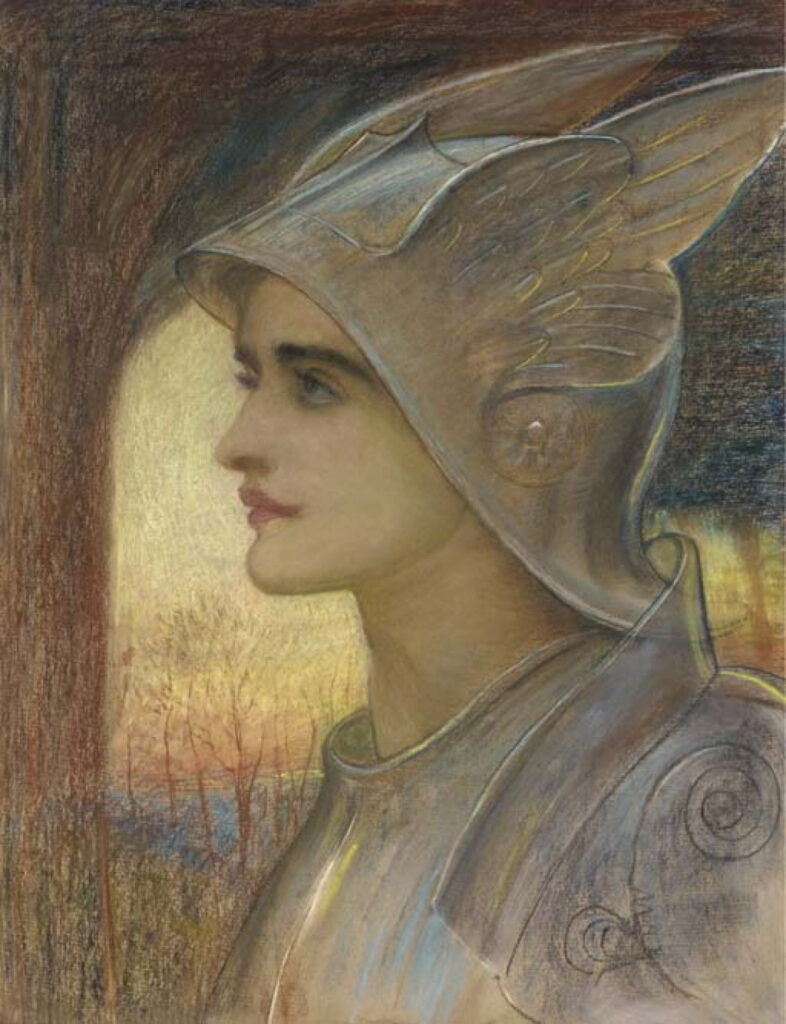Reading visual art: 137 Helmet

Helmets have long been worn by warriors to protect the head, one of the most vulnerable parts of the body in combat. They have come to symbolise the warrior, and by extension those of the gods involved with war and fighting. Perhaps the most common and conflicted in classical Mediterranean civilisations is the goddess Athena or Minerva.
Lavinia Fontana (1552–1614), Minerva Dressing (1612-13), oil on canvas, 154 cm x 115 cm, Private collection. The Athenaeum.
She usually appears dressed, making Lavinia Fontana’s Minerva Dressing from 1612-13 the more unusual. In her final years in Rome, Fontana painted two versions of this motif, of which this is the more subtle, with elaborate details of the almost transparent voile on her back, the red and black cape, and her signature plumed helmet.
Jacob Jordaens (1593–1678), The Golden Apple of Discord (1633), oil on canvas, 181 × 288 cm, Museo Nacional del Prado, Madrid, Spain. Wikimedia Commons.
Jacob Jordaens’ finished version of an original sketch by Rubens now known as The Golden Apple of Discord (1633) shows the wedding feast of the deities where Eris (Discord) makes her gift of the golden apple to set up the Judgement of Paris, leading to the Trojan War. At the left, Athena/Minerva, wearing her plumed helmet, reaches forward for that apple.
Just to confuse, the Roman goddess of war, Bellona (Greek Enyo), is also shown wearing a plumed helmet by convention.
Peter Paul Rubens (1577–1640), Portrait of Marie de’ Medici as Bellona (date not known), oil on canvas, 276 x 149 cm, Musée du Louvre, Paris. Wikimedia Commons.
Peter Paul Rubens’ undated Portrait of Marie de’ Medici as Bellona shows her in the midst of cannon, arms and armour, with an exuberantly decorated helmet, a sceptre and a statue of a winged woman.
Rembrandt Harmenszoon van Rijn (1606–1669), Bellona (1633), oil on canvas, 127 x 97.5 cm, Metropolitan Museum of Art, New York, NY. Wikimedia Commons.
To my surprise, I learned that Rembrandt painted this portrait of Bellona in 1633, when his career was flourishing in Amsterdam. Given that she’s holding the Aegis normally associated with Minerva (Athena), I wonder whether there has been a misunderstanding here, but there’s no mention of the possibility that this might be Minerva instead.
If the deity is male, the helmet is most likely to identify him as Mars/Ares.
Diego Velázquez (1599–1660), Mars (c 1639-41) [90], oil on canvas, 179 x 95 cm, Museo Nacional del Prado, Madrid, Spain. Wikimedia Commons.
It was Diego Velázquez who painted what must be the finest solo portrait of Ares, in about 1639-41. This was one of a trio of portraits ‘from antiquity’ that he painted for the king’s hunting lodge at El Pardo, near Madrid, known as the Torre de la Parada. Sometimes known as Mars Resting, the god is shown off-guard in a moment of relaxation, his armour and shield dumped on the floor, and wearing just a loincloth and helmet. He looks like he just got out of bed after a long siesta.
Many mortal warriors are also normally seen wearing an appropriate helmet. For Perseus, during his quest to behead Medusa the Gorgon, this was the helmet of Hades to make him invisible.
Edward Burne-Jones (1833–1898), The Perseus Series: The Death of Medusa I (1882), bodycolour, 124.5 × 116.9 cm, Southampton City Art Gallery, Southampton, England. Wikimedia Commons.
The fifth in Edward Burne-Jones’ Perseus series, The Death of Medusa I (1882), shows Perseus just after he has cut Medusa’s head off, and holds it aloft with his left hand, at the far right edge of the painting. He holds his adamantine sword in the other hand, with the kibisis to contain her head slung around his neck. His helmet is winged to match his sandals, which give him the power of flight.
Several of those warriors who fought at Troy are associated with their helmets.
Benjamin West (1738–1820), Thetis Bringing the Armour to Achilles (1804), oil on canvas, 68.6 x 50.8 cm, Los Angeles County Museum of Art, Los Angeles, CA. Wikimedia Commons.
After his close friend Patroclus had been killed while wearing his armour, Achilles demanded a fresh suit made by Vulcan/Hephaestus before he would return to engage in battle. Benjamin West’s Thetis Bringing the Armour to Achilles from 1804 shows the Greek warrior being presented with the armour and helmet by his mother Thetis.
Simon Vouet (1590-1649), Aeneas and his Father Fleeing Troy (c 1635), oil on canvas, dimensions not known, San Diego Museum of Art, San Diego, CA. Image by Wmpearl, via Wikimedia Commons.
Simon Vouet’s Aeneas and his Father Fleeing Troy from about 1635 shows the family group in close-up. From the left are Creusa, Aeneas’ wife who died before she could leave the city, Aeneas wearing his helmet, Anchises, and a very young Ascanius. This is the start of their flight, as Aeneas and Creusa are persuading Anchises to let Aeneas carry him to safety.
Helmets are common among warriors of chivalric days, including those of Arthurian legend.
William Dyce (1806–1864), Piety: The Knights of the Round Table about to Depart in Quest of the Holy Grail (1849), watercolour and bodycolour over pencil on buff paper, laid down, 23.3 x 44 cm, Scottish National Gallery, Edinburgh, Scotland. Wikimedia Commons.
William Dyce’s watercolour of Piety: The Knights of the Round Table about to Depart in Quest of the Holy Grail (1849) is his study for this fresco for the Queen’s Robing Room in the Palace of Westminster, a start to the revival of Arthurian legendary art in the nineteenth century. It shows a melée of knights of the Round Table paying tribute to King Arthur and Queen Guinevere (at the right), as those knights prepare to depart on their quest for the Holy Grail. There’s a rich range of helmets on display.
Helmets pose problems for visual artists, in that they at least partially obscure the head, and when equipped with a visor they make identification of the wearer extremely difficult. Where the head and face are of particular importance, the artist may need to pose the subject with their helmet held rather than worn.
Harold Piffard (1867-1938), Joan of Arc (date not known), oil on canvas, 91.5 × 72.2 cm, location not known. Wikimedia Commons.
Harold Piffard’s portrait of Joan of Arc from about 1900 follows contemporary conventions, showing her bearing a standard, wearing a fine suit of black armour, and holding her helmet in the crook of her left arm.
William Blake Richmond (1842–1921), St Joan of Arc (date not known), pencil and pastel on buff paper, 71.3 × 56 cm, location not known. Wikimedia Commons.
William Blake Richmond’s pastel portrait of St Joan of Arc from about the same time adopts a more symbolic approach. Joan’s face appears made up, with lipstick and honed eyebrows and eyelashes, her armour fancifully faired and her helmet swept into wings.



